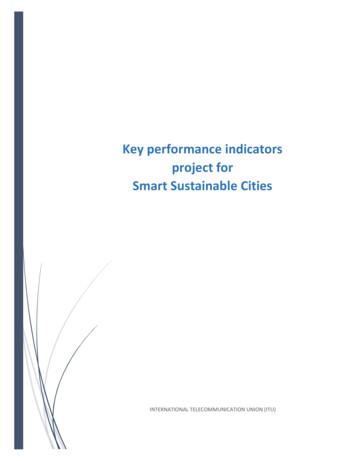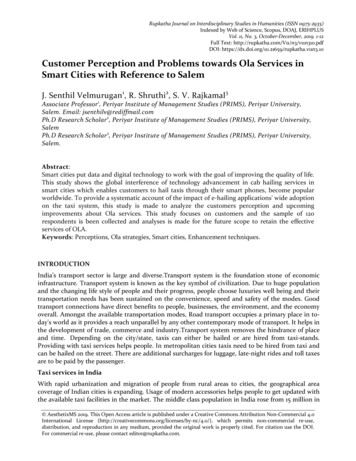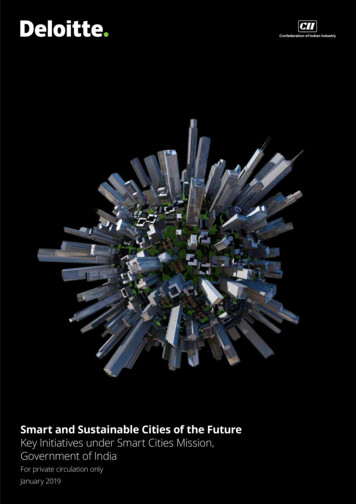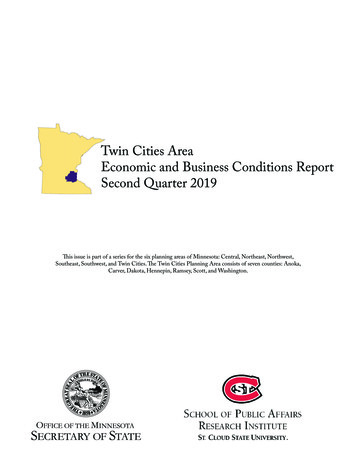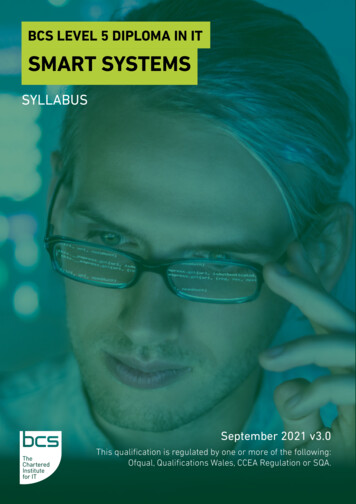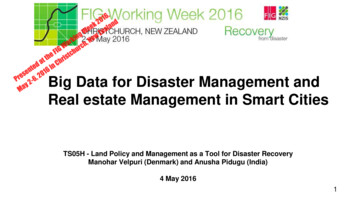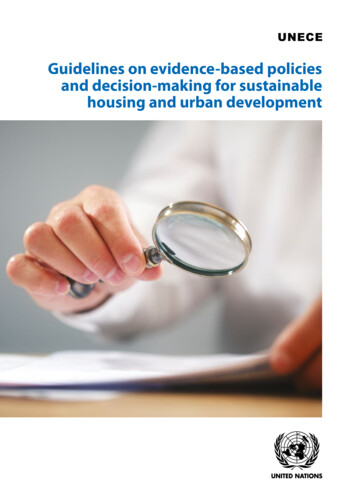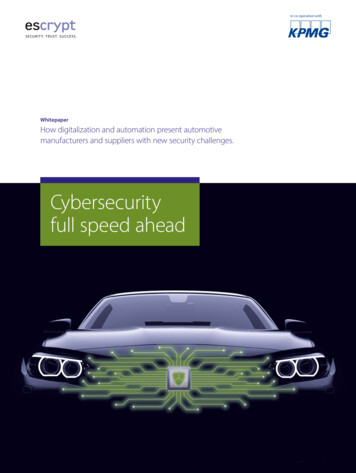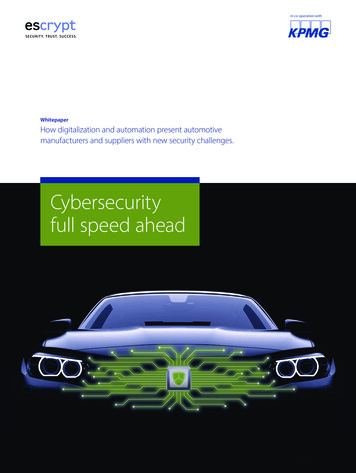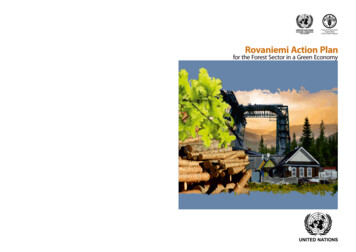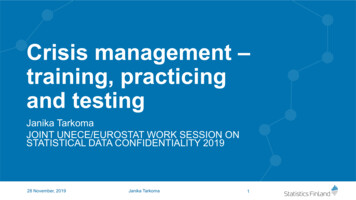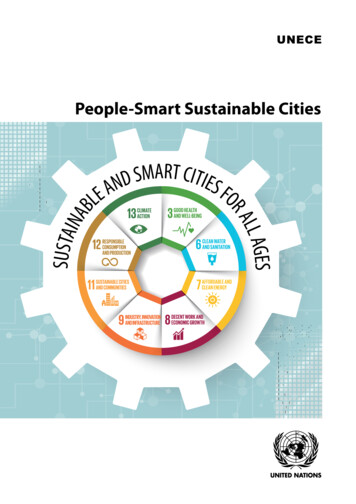
Transcription
esCitiesSSUUSTAISTAINNABABAGESALLLL AGESRR AARATRTCICTITEIEMMSSDDNANSSAFFOOEELL
People-SmartSustainable CitiesGeneva, 2020
iiPEOPLE-SMART SUSTAINABLE CITIESNOTERequests to reproduce excerpts or to photocopy should be addressed to the Copyright Clearance Center at:copyright.comAll other queries on rights and licenses, including subsidiary rights,should be addressed to:United Nations Publications405 East 42nd StreetS-09FW001New York, NY 10017United States of AmericaEmail: permissions@un.orgWebsite: https://shop.un.orgThe findings, interpretations, and conclusions expressed herein are those of the author(s) and do not necessarilyreflect the views of the United Nations or its officials or Member States.The designations employed and the presentation of material on any map in this work do not imply the expressionof any opinion whatsoever on the part of the United Nations concerning the legal status of any country, territory,city or area or of its authorities, or concerning the delimitation of its frontiers or boundaries.Links contained in the present publication are provided for the convenience of the reader and are correct at thetime of issue. The United Nations takes no responsibility for the continued accuracy of that information or for thecontent of any external website.This publication is issued in English and Russian.Photo credits: depositphotos.com & UN PhotosECE/INF/2020/3UNITED NATIONS PUBLICATIONSales No. E.20.II.E.40ISBN 978-92-1-117256-0eISBN 978-92-1005265-8 2020 United NationsAll rights reserved worldwideUnited Nations publication issued by theUnited Nations Economic Commission for Europe
PEOPLE-SMART SUSTAINABLE CITIESFOREWORDThe 2030 Agenda for Sustainable Development, with its seventeen Sustainable Development Goals (SDGs), providesan ambitious and comprehensive framework that opens new perspectives for policymaking and internationalcooperation. While progress on its implementation is being made, current efforts are far below the scale needed todeliver the SDGs within the next ten years. Ambitious action becomes even more important in the context of theresponse to the COVID-19 pandemic: the SDGs are vital for a recovery that leads to greener, more inclusive economies,and stronger, more resilient countries.UNECE supports its member States in the implementation of the 2030 Agenda through concrete and results-orientedactivities, in areas covered in its eight sub-programmes: environment, transport, statistics, economic cooperation andintegration,Forewordsustainable energy, trade, timber and forestry, and housing, land management and population.the lastcentury,differentand rawmaterialsectors, as wellcountries, manner, in line withThis multi-sectoralOverstructurehasallowedUNECEenergyto addressSDGimplementationin ndmanageresources.Newchallengesthethe interlinked character of the SDGs, and to adopt a new way of working that cuts across tosectoralboundaries. Fourproduction, distribution and utilization of energy and raw materials have, however,nexus areas have been defined where multiple SDGs converge:emerged in recent years that demand innovative approaches for an integrated resourceuse of system.natural resourcesy SustainablemanagementThe 2030 Agenda for Sustainable Development defines a clearpathwaytoaddresstheseforchallengesall ages in a holistic manner.y Sustainable and smart citiesUnitedandNationsClassification for Resources (UNFC) was developedmobilitysmartFrameworkconnectivityy SustainableTheunder the auspices of the United Nations Economic Commission for Europe by a dedicatedand monitoring progress towards the SDGs.y Measuringcommunity of experts drawn from a range of fields, but with the common goal to developan internationally applicable scheme for the classification, reporting and management ofIn each of theseareas, a cross-sectoral, inter-divisional team of UNECE experts has undertaken an in-depth substantiveenergy and mineral resources. Though initially developed for the mineral and petroleumanalysis of current and future challenges and needs of UNECE member States and identified ways and means tosectors, UNFC has recently expanded its scope to include renewable energy. Growingaddress them,thus assistingmemberStates toenergydesignresources,and implementpoliciesin theseawarenessand interestin s areas. The findingsof these d a need to standardize the way in which renewable energy potential is classifiedand reported.The publication People-Smart Sustainable Cities prepared within the “Sustainable and smart cities for all ages” nexusTo facilitateimprovedglobal communicationin the geothermal sector, the ECEadvocates a “cities-based”approachto sustainabledevelopment.Expert Group on Resource Classification, under the framework of a Memorandum ofUnderstandingthe UnitedNationsEconomicEurope andtheThe publicationhighlightsbetweenthat, similarly,to thefinancialcrisis Commissionof 2008, theforCOVID-19pandemichas shown pedspecificationsforapplyingUNFCtodifferent cities have different capacities to cope with crises. Both the pandemic and the economic crisis caused bygeothermal energy resources. The specifications were issued in September 2016.lockdown measures have disproportionally affected different cities as well as different groups of the population; theA set ofof14societycase studiesAustralia,most vulnerable groupshavefromsufferedmost.Germany, Hungary, Iceland, Italy, Netherlands,New Zealand, Philippines and Russian Federation are presented here to facilitate a betterunderstandingof the specificationsand the uniformapplicationUNFCto geothermalCities possessmassive resources,talent and creativityand serveas hubsofforknowledgesharing, llustratetheclassificationofarangeofdifferentand innovation, generating new ideas, embedding these solutions locally and scaling-up successful practices. Cities,geothermalresourcescenarios in a mannerconsistentother energyThelive, work, study andhowever, arenot abstractsustainability-makingmachines;they withare placeswhere resources.real peopleapproach also provides valuable indicators to the value of UNFC as a tool to supportflourish. Cities are made of people, by people and for people. Sustainable measures will have to make sense toattainment of the Sustainable Development Goals.inhabitants of cities, making their life more liveable. Furthermore, it is people who drive sustainability and who are itsExpertsin geothermalresources, asthewellas thosein other energysustainableand mineral cities, introduced inultimate source andbeneficiaries.This energyvision underpinsnotionof udiesausefulreferencedocumentintheir effortsthis publication.to apply a globally applicable integrated resource management system. I commend allthose involvedthe preparation,reviewusefuland verificationcase studiesthank,I trust that theseflagship inpublicationswill offerguidance ofto thesegovernmentsandandotherstakeholders ciationforitssupport.in developing integrated solutions to the multifaceted challenges of our time and in building back better from theCOVID-19 pandemic.Olga AlgayerovaOlga AlgayerovaUnder-Secretary-Generalof the United NationsExecutiveSecretaryExecutive Secretary of the United NationsEconomic Commission for EuropeUnited Nations Economic Commission for Europeiii
ivPEOPLE-SMART SUSTAINABLE CITIESTABLE OF CONTENTSForeword . . . . . . . . . . . . . . . . . . . . . . . . . . . . . . . . . . . . . . . . . . . . . . . . . . . . . . . . . . . . . . . . . . iiiAcknowledgements . . . . . . . . . . . . . . . . . . . . . . . . . . . . . . . . . . . . . . . . . . . . . . . . . . . . . . . . . . . viAbbreviations . . . . . . . . . . . . . . . . . . . . . . . . . . . . . . . . . . . . . . . . . . . . . . . . . . . . . . . . . . . . . . . viiExecutive Summary . . . . . . . . . . . . . . . . . . . . . . . . . . . . . . . . . . . . . . . . . . . . . . . . . . . . . . . . . . . .ixCHAPTER 1: A CITIES-BASED APPROACH TO SUSTAINABILITY . . . . . . . . . . . . . . . . . . . . . . . . . . 11.1 A policy nexus for sustainable development . . . . . . . . . . . . . . . . . . . . . . . . . . . . . . . . . . . . . . . 11.2 Defining people-smart sustainable cities. . . . . . . . . . . . . . . . . . . . . . . . . . . . . . . . . . . . . . . . . . 3CHAPTER 2: TRENDS AND CHALLENGES FOR URBAN FUTURES .2.1 Urbanization and globalization . . . . . . . . . . . . . . . . . . . . .2.2 Geographical disparities . . . . . . . . . . . . . . . . . . . . . . . . .2.3 Crises, pandemics and uncertainties. . . . . . . . . . . . . . . . . .2.4 Digital revolution . . . . . . . . . . . . . . . . . . . . . . . . . . . . . .2.5 Population ageing . . . . . . . . . . . . . . . . . . . . . . . . . . . . .2.6 Climate and environmental challenges . . . . . . . . . . . . . . . .2.7 Natural and technological hazards . . . . . . . . . . . . . . . . . . . . . . . . . . . . . . . . . . . . . . . . . . . . . . . . . . . . . . . . . . . . . . . . . . . . . . . . . . . . . . . . . . . . . . . . . . . . . . . . . . . . . . . . . . . . 7. . . . .7. . . . .8. . . . 11. . . . 13. . . . 16. . . . 18. . . . 20CHAPTER 3: HOW CITIES FOSTER SUSTAINABILITY AND LIVEABILITY . . . . .3.1 Every city matters. . . . . . . . . . . . . . . . . . . . . . . . . . . . . . . . . . . . . . .3.2 Is there city after COVID-19? . . . . . . . . . . . . . . . . . . . . . . . . . . . . . . . .3.3 Living in digital worlds . . . . . . . . . . . . . . . . . . . . . . . . . . . . . . . . . . .3.4 Cities that make life comfortable for all . . . . . . . . . . . . . . . . . . . . . . . . .3.5 Climate neutral cities . . . . . . . . . . . . . . . . . . . . . . . . . . . . . . . . . . . .3.6 Eco-friendly and healthy cities . . . . . . . . . . . . . . . . . . . . . . . . . . . . . .3.7 Value out of waste . . . . . . . . . . . . . . . . . . . . . . . . . . . . . . . . . . . . . .3.8 When disaster strikes . . . . . . . . . . . . . . . . . . . . . . . . . . . . . . . . . . . . . . . . . . . . . . . . . . . . . . . . . . . . . . . . . . . . . . . . . . . . . . . . . . . . . . . . . . . . . . . . . . . . . . . . . .232326293339444749CHAPTER 4: HOW CITIES HARNESS THEIR POTENTIAL AND CAPABILITIES . .4.1 Create, innovate, reflect. . . . . . . . . . . . . . . . . . . . . . . . . . . . . . . . . . .4.2 Know what works and what does not . . . . . . . . . . . . . . . . . . . . . . . . . .4.3 Mobilise finance for a good cause . . . . . . . . . . . . . . . . . . . . . . . . . . . .4.4 Work with people and for people. . . . . . . . . . . . . . . . . . . . . . . . . . . . .4.5 Make the most out of spatial planning . . . . . . . . . . . . . . . . . . . . . . . . .4.6 Cooperate across borders . . . . . . . . . . . . . . . . . . . . . . . . . . . . . . . . . . . . . . . . . . . . . . . . . . . . . . . . . . . . . . . . . . . . . . . . . . . . . . . . . . . . . . .53535657596263.CHAPTER 5: SUMMARY POINTS. . . . . . . . . . . . . . . . . . . . . . . . . . . . . . . . . . . . . . . . . . . . . 67References . . . . . . . . . . . . . . . . . . . . . . . . . . . . . . . . . . . . . . . . . . . . . . . . . . . . . . . . . . . . . . . . . 69LIST OF FIGURESFigure 1:Figure 2:Figure 3:Figure 4:Figure 5:Figure 6:Figure 7:Percentage of the population residing in urban areas: United Nations forecast for 2020 and 2050 . . . .GDP PPP per capita in ex-socialist countries compared to the world, European Union and China, 2019.Distribution of urban population by settlement size, 2015. . . . . . . . . . . . . . . . . . . . . . . . . . . .The causation of disaster risk . . . . . . . . . . . . . . . . . . . . . . . . . . . . . . . . . . . . . . . . . . . . . .Options of mobility as a Service. . . . . . . . . . . . . . . . . . . . . . . . . . . . . . . . . . . . . . . . . . . . .Experimental culture in government . . . . . . . . . . . . . . . . . . . . . . . . . . . . . . . . . . . . . . . . .COVID cycling lane in New Brighton . . . . . . . . . . . . . . . . . . . . . . . . . . . . . . . . . . . . . . . . . .8.91020315455
PEOPLE-SMART SUSTAINABLE CITIESLIST OF BOXESBox 1:Box 2:Box 3:Box 4:Box 5:Box 6:Box 7:Box 8:Box 9:Box 10:Box 11:Box 12:Box 13:Box 14:Box 15:Box 16:Box 17:Box 18:Box 19:Box 20:Box 21:Box 22:Box 23:Box 24:Box 25:Box 26:Box 27:Box 28:Box 29:Box 30:Box 31:Box 32:Box 33:Box 34:Box 35:What is UNECE and the UNECE region? . . . . . . . . . . . . . . . . . . . . . . . . . . . . . . . . . . . . . . . .Defining innovation . . . . . . . . . . . . . . . . . . . . . . . . . . . . . . . . . . . . . . . . . . . . . . . . . . . .The New Urban Agenda and its implementation in the UNECE region . . . . . . . . . . . . . . . . . . . .United for Smart Sustainable Cities . . . . . . . . . . . . . . . . . . . . . . . . . . . . . . . . . . . . . . . . . .Urban deindustrialization and monotowns . . . . . . . . . . . . . . . . . . . . . . . . . . . . . . . . . . . . .The Geneva Ministerial Declaration on Sustainable Housing and Urban Development. . . . . . . . . .Smartphone applications for city users . . . . . . . . . . . . . . . . . . . . . . . . . . . . . . . . . . . . . . . .A surveillance feast in time of pandemics: a glimpse of the dystopian future? . . . . . . . . . . . . . . .Smart ageing for sustainable cities. . . . . . . . . . . . . . . . . . . . . . . . . . . . . . . . . . . . . . . . . . .The Paris Agreement. . . . . . . . . . . . . . . . . . . . . . . . . . . . . . . . . . . . . . . . . . . . . . . . . . . .Transport, Health and Environment Pan-European Programme (THE PEP). . . . . . . . . . . . . . . . . .How Murmansk plans to reverse its population decline . . . . . . . . . . . . . . . . . . . . . . . . . . . . .The foundational economy – a spatial strategy for everyone everywhere . . . . . . . . . . . . . . . . . .The Intelligent Cities Challenge . . . . . . . . . . . . . . . . . . . . . . . . . . . . . . . . . . . . . . . . . . . . .The “hyper-proximity” plan of Paris. . . . . . . . . . . . . . . . . . . . . . . . . . . . . . . . . . . . . . . . . . .Urban transport statistics and COVID-19 . . . . . . . . . . . . . . . . . . . . . . . . . . . . . . . . . . . . . . .The benefits of platform economy . . . . . . . . . . . . . . . . . . . . . . . . . . . . . . . . . . . . . . . . . . .Mobility as a service . . . . . . . . . . . . . . . . . . . . . . . . . . . . . . . . . . . . . . . . . . . . . . . . . . . .Smart city experiments in Toronto and Barcelona . . . . . . . . . . . . . . . . . . . . . . . . . . . . . . . . .“Comfortable city” programme of Moscow . . . . . . . . . . . . . . . . . . . . . . . . . . . . . . . . . . . . .Addressing climate neutrality in buildings through the international centres of excellence. . . . . . .The equitable access principles of the Protocol on Water and Health . . . . . . . . . . . . . . . . . . . . .The World Forum for Harmonization of Vehicle Regulations . . . . . . . . . . . . . . . . . . . . . . . . . . .International standards for preventing food losses . . . . . . . . . . . . . . . . . . . . . . . . . . . . . . . .Urban Living Labs as experimental platforms . . . . . . . . . . . . . . . . . . . . . . . . . . . . . . . . . . . .The small industrial town of Renens reinventing itself through innovation ecosystems . . . . . . . . .UNECE Portal on Standards for the Sustainable Development Goals . . . . . . . . . . . . . . . . . . . . .What Works Centres in the United Kingdom. . . . . . . . . . . . . . . . . . . . . . . . . . . . . . . . . . . . .People-first Public-Private Partnership instruments . . . . . . . . . . . . . . . . . . . . . . . . . . . . . . . .The Aarhus Convention and its Protocol on Pollutant Release and Transfer Registers . . . . . . . . . . .Engaging citizens: public participation platforms . . . . . . . . . . . . . . . . . . . . . . . . . . . . . . . . .The Protocol on Strategic Environmental Assessment. . . . . . . . . . . . . . . . . . . . . . . . . . . . . . .Multilateral environmental agreements to support transboundary cooperation and risk mitigation .Sustainable transit in the Cardiff Capital Region . . . . . . . . . . . . . . . . . . . . . . . . . . . . . . . . . .UNECE Forum of Mayors . . . . . . . . . . . . . . . . . . . . . . . . . . . . . . . . . . . . . . . . . . . . . . . . . 55565758606163636465LIST OF TABLESTable 1:Table 2:Table 3:Contribution of robotics and autonomous systems to solving urban challenges. . . . . . . . . . . . . . 13Multi-scale framework for sustainable housing policy . . . . . . . . . . . . . . . . . . . . . . . . . . . . . . 34Examples of social infrastructure . . . . . . . . . . . . . . . . . . . . . . . . . . . . . . . . . . . . . . . . . . . . 35v
viPEOPLE-SMART SUSTAINABLE CITIESACKNOWLEDGEMENTSThe publication “People-Smart Sustainable Cities” was developed by the United Nations Economic Commission forEurope as a part of the work of its nexus on “Sustainable and smart cities for all ages”.Valuable contributions were received from the members of the nexus. The following people are acknowledged fortheir contributions:Author:Dr. Oleg Golubchikov . . . . . . . . . . . . Professor, Lecturer, Cardiff University; UNECE ConsultantContributing members from the UNECE nexus on sustainable and smart cities for all ages:Ms. Monika Linn . . . . . . . . . . . . . . . Project Leader, Chief, Sustainable Development and Gender UnitMs. Paola Deda . . . . . . . . . . . . . . . . Director, Forests, Land and Housing DivisionMr. Scott Foster . . . . . . . . . . . . . . . . Director, Sustainable Energy DivisionMr. Tony Bonnici . . . . . . . . . . . . . . . Economic Affairs Officer, Cooperation and Partnerships SectionMr. Francesco Dionori . . . . . . . . . . . . Chief, Transport Section and Secretary of the Working Party onRail TransportMr. Anders Jönsson . . . . . . . . . . . . . Chief, Innovative Policies Development SectionMs. Vitalija Gaucaite Wittich . . . . . . . Chief, Population Unit, Statistical DivisionMs. Gulnara Roll. . . . . . . . . . . . . . . . Secretary to the Committee on Urban Development, Housing andLand Management, Forests, Land and Housing DivisionMs. Lorenza Jachia . . . . . . . . . . . . . . Secretary to the Working Party on Regulatory Cooperation andStandardization Policies, Economic Cooperation and Trade DivisionMs. Franziska Hirsch . . . . . . . . . . . . . Secretary to the Convention on the Transboundary Effects ofIndustrial Accidents, Environment DivisionMr. Roel Janssens. . . . . . . . . . . . . . . Economic Affairs Officer, Transport DivisionEditors:Ms. Cecilia Batac . . . . . . . . . . . . . . . Statistics Assistant, UNECEMr. Max Goodall . . . . . . . . . . . . . . . ConsultantThe following consultants have also contributed to the preparation of the study:Ms. Nadiia YeremenkoMs. Rebecca WardleMr. Fabio El Khoury
PEOPLE-SMART SUSTAINABLE CITIESABBREVIATIONSBIM . . . . . . . . . . . . . . . Building Information ModellingCO2 . . . . . . . . . . . . . . . Carbon DioxideECE . . . . . . . . . . . . . . . Economic Commission for EuropeEIA . . . . . . . . . . . . . . . Environmental impact assessmentESPON. . . . . . . . . . . . . European Territorial Observatory NetworkEU . . . . . . . . . . . . . . . European UnionEU15 . . . . . . . . . . . . . . Countries which joined the European Union prior to the 2004 enlargementGDP . . . . . . . . . . . . . . Gross Domestic ProductGHG . . . . . . . . . . . . . . Greenhouse GasesGHSL. . . . . . . . . . . . . . Global Human Settlement LayerGIS . . . . . . . . . . . . . . . Geographical Information SystemsGIZ . . . . . . . . . . . . . . . Gesellschaft für Internationale ZusammenarbeitGPS. . . . . . . . . . . . . . . Global Positioning SystemGVA . . . . . . . . . . . . . . Gross value addedICT . . . . . . . . . . . . . . . Information and Communication TechnologyICLEI . . . . . . . . . . . . . . International Council for Local Environmental InitiativesITU . . . . . . . . . . . . . . . International Telecommunication UnionJRC . . . . . . . . . . . . . . . Joint Research Centre for the European CommissionJTM. . . . . . . . . . . . . . . Just Transition MechanismNaTech . . . . . . . . . . . . Natural hazards triggering technological disastersNDC . . . . . . . . . . . . . . Nationally determined contributionsOECD . . . . . . . . . . . . . Organization for Economic Co-operation and DevelopmentOSCE. . . . . . . . . . . . . . Organization for Security and Co-operation in EuropePPP . . . . . . . . . . . . . . Purchasing Power ParityPRTR . . . . . . . . . . . . . . Kyiv Protocol on Pollutant Release and Transfer RegistersSDGs . . . . . . . . . . . . . . Sustainable Development GoalsSEA. . . . . . . . . . . . . . . UNECE Protocol on Strategic Environmental AssessmentSMEs . . . . . . . . . . . . . . Small and medium enterprisesSSC . . . . . . . . . . . . . . . Smart Sustainable CitiesTHE PEP . . . . . . . . . . . . Transport, Health and Environment Pan-European ProgrammeU4SSC . . . . . . . . . . . . . United for Smart Sustainable CitiesUK . . . . . . . . . . . . . . . United Kingdom of Great Britain and Northern IrelandUN . . . . . . . . . . . . . . . United NationsUN DESA . . . . . . . . . . . United Nations Department of Economic and Social AffairsUN-Habitat . . . . . . . . . . United Nations Human Settlement ProgrammeUNDP . . . . . . . . . . . . . United Nations Development ProgrammeUNFCCC. . . . . . . . . . . . United Nations Framework Convention on Climate ChangeUNECE. . . . . . . . . . . . . United Nations Economic Commission for EuropeUNDRR . . . . . . . . . . . . United Nations Office for Disaster Risk ReductionWHO . . . . . . . . . . . . . . World Health OrganizationWP.29 . . . . . . . . . . . . . World Forum for Harmonization of Vehicle Regulationvii
UN PHOTO / MATIJA POTOCNIK
PEOPLE-SMART SUSTAINABLE CITIESEXECUTIVE SUMMARYA cities-based approach to sustainable developmentThe 2030 Agenda for Sustainable Development provides an ambitious and comprehensive plan of action with its 17Sustainable Development Goals (SDGs). To advance the 2030 Agenda, the United Nations Economic Commission forEurope (UNECE) (see box 1) has adopted a “nexus” approach in its work, focusing on high-impact nexus areas wheremultiple SDGs converge. This flagship publication is related to one of those high impact nexus areas: “Sustainable andsmart cities for all ages”.This publication advocates a “cities-based” approach to sustainable development. This approach recognises thecentral and integrating role that cities and urban living play in developing sustainability. As a dominant form of spatialorganization within society today, cities are the centrepiece of economic, social, and cultural life. Without localisingSDGs at the urban level, few can be effectively addressed at all. By their nature, cities represent a complex arrangementof many interrelated systems, both social and technical, so that they are best placed to address multiple sustainabilitygoals at once. Cities also offer more rapid, practice-informed and grounded responses to sustainability challenges.Box 1: What is UNECE and the UNECE region?The United Nations Economic Commission for Europe (UNECE) was set up in 1947 as one of five regional commissions ofthe United Nations with a major aim to promote pan-European policy cooperation. UNECE includes 56 member States –which is collectively referred to in this publication as the UNECE region. The region includes all the countries of Europe,as well as countries in North America (Canada and United States), Central Asia (Kazakhstan, Kyrgyzstan, Tajikistan,Turkmenistan and Uzbekistan) and Western Asia (Israel).The UNECE region is essentially the global north, broadly the wealthiest region of the world. However, the region alsoincludes countries at the middle or lower middle-income levels of economic development, including those emergingfrom the dissolution of the Soviet Union. This diversity represents a challenge for UNECE, as the organization mustrespond to the expectations of its different members. However, it is also an advantage, as it encourages the sharing ofdiverse experience and knowledge, as well as financial and technical aid for countries in need.As a multilateral platform, UNECE facilitates greater economic integration and cooperation among its member Statesand promotes their sustainable development and economic prosperity through policy dialogue; knowledge sharingand the exchange of experiences, best practices and technical expertise; negotiation of international legal instruments;development of regulations and norms; and technical cooperation for countries with economies in transition. The UNECEalso contributes to enhancing the effectiveness of the United Nations through the regional implementation of outcomesof global United Nations conferences, summits and agreements.Liveability and sustainability for allCities possess massive resources, talent and creativity and serve as hubs for innovation, knowledge sharing andexperimentation, facilitating the process of generating new ideas, embedding them locally and scaling-up whatworks best. Cities, however, are not abstract sustainability machines; they are where real people live, work, studyand fulfil themselves. Cities are made of people, by people and for people. Sustainable measures therefore mustmake sense for inhabitants of cities, making their life more liveable. Furthermore, it is people who drive sustainabilityand are its ultimate source and beneficiaries. This vision underpins the notion of “people-smart sustainable cities”,introduced in this publication.ix
xPEOPLE-SMART SUSTAINABLE CITIES“People-smart sustainable cities” engage with sustainability in an inclusive, collaborative and equitable way. Whilefostering sustainability across their environmental, economic, social and cultural dimensions, these cities providethe necessary conditions and infrastructure to enhance the capabilities of their citizens to contribute to, and enjoythe benefits of, a more liveable, resilient and sustainable urban development. These cities enable the meaningfulparticipation of citizens in fulfilling their right to the city; they focus on making cities more prosperous, equitable,comfortable and innovative; they address social needs and make sure housing and urban services are high-quality andaffordable; they cater for the needs of the vulnerable and those with disabilities; and they are also gender-sensitiveand age-responsive, acknowledging the different and changing needs of residents at different stages of their life.Societal trends and challengesThe fundamental role of cities in driving sustainable development interplays with big societal trends and challengesto which all cities must adapt, but which also produce new opportunities.(a) Globalization and urbanization. These two processes support each other: globalization causes people move tocities - with their benefits of agglomeration, while urbanization fosters economic and cultural interdependenceof the world and creates a planetary-wide ecological footprint.(b) Geographic disparities. Besides the persistence of social inequalities, which produce issues with spatialsegregation, unequal standards of living and a lack of housing affordability within cities, large economicinequalities exist between larger metropolitan areas and smaller, peripheral and old industrial cities, resultingin an uneven quality of life and different life opportunities for their residents.(c) Crises and pandemics. The financial crisis of 2008 and the outbreak of COVID-19 have contributed to newglobal instabilities, intensifying underlying the economic and social problems of cities.(d) Digital transitions. Information and communications technologies (ICTs) and the fourth industrial revolutionoffer new opportunities for managing cities more efficiently and holistically and for enhancing wellbeing ofpeople and introduce new challenges to privacy and democracy.(e) Population ageing. Ageing produces specific demands on urban infrastructure, health and social care system,housing and public space, and expands the “silver economy”, which already makes up a considerable share ofurban economies.(f ) Climatic and environmental challenges. As well as facing global transformations associated with climatechange and their inferences for energy transitions, cities are also faced with localized environmental pressures,such as air, water and noise pollution, which influence public health.(g) Natural and technological hazards. Urbanization decreases distances between population centres, industrialareas, flood plains, seashores and other areas prone to the impacts of natural hazards and increases theexposure of the population to technological hazards.What do cities do to foster sustainability and liveability in an integrated manner?The UNECE region is a home to cities that are leading the way to becoming sustainable themselves and contributingto overall world sustainability. UNECE strategic policy instruments, experiences, good practices and lessons learnedsupport policymaking for people-smart and sustainable cities – both at the level of national governments and cities.This publication discusses a few important cross-sectoral areas, in which the potential of cities is directed towardsaddressing the big societal trends and challenges in an integrated manner, while fostering sustainability and liveability.Every
People-Smart Sustainable Cities S U S T A I N A B L E A N D C S M A R T I T I E S F O R A L L A G E S UNECE UNITED NATIONS People-Smart Sustainable Cities People-Smart Sustainable Cities S U S T A I N A B L E A N D C S M A R T I T I S F A L L A G E S Palais des Nations CH - 1211 Geneva 10, Switzerland Telephone: 41(0)22 917 12 34 E-mail: unece .
